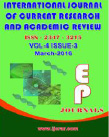Abstract Volume:4 Issue-3 Year-2016 Original Research Articles
 |
Online ISSN : 2347 - 3215 Issues : 12 per year Publisher : Excellent Publishers Email : editorijcret@gmail.com |
2Department of Genetics and Plant Breeding, G. B. Pant University of Agriculture and Technology Pantnagar, 263145, U. S. Nagar, Uttarakhand, India
3Department of Bíological Sciences, G. B. Pant University of Agriculture and Technology Pantnagar, 263145, U. S. Nagar, Uttarakhand, Indi.
4Department of MBGE, G. B. Pant University of Agriculture and Technology Pantnagar, 263145, U. S. Nagar, Uttarakhand, India
With the optimal temperatures higher than 800C, the hyperthermophilic microbes are now in focus due to their unique enzymatic systems. Initially they found in hot springs of Yellow Stone National Park. The enzymes synthesized by hyperthermophilic bacteria and archaea, also called hyperthermophilic enzymes or sometimes thermozymes are typically thermostable and are optimally active at high temperatures, thus lead to the remarkable heat stability properties for multiple biotechnological and various enzymatic processes. Many literatures reported that the thermozymes share the same catalytic mechanism with their mesophilic counterparts i.e. when cloned and expressed in mesophilic hosts, usually retain their thermal property. This property is very useful because omitting the drawbacks come in enzyme production and cultivation of hyperthermophiles. This review concentrates on the various thermozymes, industrially produced from hyperthermophilic microorganisms. The advantages for various biotechnological processes, the sources and important properties of various hyperthermophilic enzymes are briefly described. Furthermore, their various applications in different processes are also summarized in this review.
How to cite this article:
Raj Kumar Pandey, Anupam Barh, Dinesh Chandra, Satish Chandra, Vishakha Pandey, Pankaj and Lakshmi Tewari. 2016. Biotechnological Applications of Hyperthermophilic Enzymes.Int.J.Curr.Res.Aca.Rev. 4(3): 39-47doi: http://dx.doi.org/10.20546/ijcrar.2016.403.005



Quick Navigation
- Print Article
- Full Text PDF
- How to Cite this Article
- on Google
- on Google Scholor
- Citation Alert By Google Scholar
